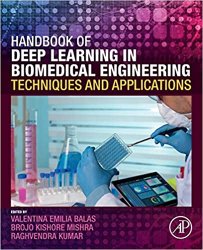Handbook of Deep Learning in Biomedical Engineering: Techniques and Applications
- Добавил: alex66
- Дата: 3-12-2020, 07:26
- Комментариев: 0

Название: Handbook of Deep Learning in Biomedical Engineering: Techniques and Applications
Автор: Editors: Valentina Balas, Brojo Mishra, Raghvendra Kumar
Издательство: Academic Press
Год: 2021
Формат: PDF
Страниц: 307
Размер: 14.01 МБ
Язык: English
Deep learning (DL) is a method of machine learning, running over artificial neural networks, that uses multiple layers to extract high-level features from large amounts of raw data. DL methods apply levels of learning to transform input data into more abstract and composite information. Handbook for Deep Learning in Biomedical Engineering: Techniques and Applications gives readers a complete overview of the essential concepts of DL and its applications in the field of biomedical engineering.
DL has been rapidly developed in recent years, in terms of both methodological constructs and practical applications. DL provides computational models of multiple processing layers to learn and represent data with higher levels of abstraction. It is able to implicitly capture intricate structures of large-scale data and is ideally suited to many of the hardware architectures that are currently available. The ever-expanding amount of data that can be gathered through biomedical and clinical information sensing devices necessitates the development of machine learning and artificial intelligence techniques such as DL and convolutional neural networks to process and evaluate the data. Some examples of biomedical and clinical sensing devices that use DL include computed tomography (CT), magnetic resonance imaging (MRI), ultrasound, single photon emission computed tomography (SPECT), positron emission tomography (PET), magnetic particle imaging, electroencephalography/magnetoencephalography (EE/MEG), optical microscopy and tomography, photoacoustic tomography, electron tomography, and atomic force microscopy. Handbook for Deep Learning in Biomedical Engineering: Techniques and Applications provides the most complete coverage of DL applications in biomedical engineering available, including detailed real-world applications in areas such as computational neuroscience, neuroimaging, data fusion, medical image processing, neurological disorder diagnosis for diseases such as Alzheimer’s, attention deficit hyperactivity disorder (ADHD), and autism spectrum disorder (ASD), tumor prediction, and translational multimodal imaging analysis.
Key Features
Presents a comprehensive handbook of the biomedical engineering applications of DL, including computational neuroscience, neuroimaging, time series data such as MRI, functional MRI, CT, EEG, MEG, and data fusion of biomedical imaging data from disparate sources, such as X-Ray/CT.
Helps readers understand key concepts in DL applications for biomedical engineering and health care, including manifold learning, classification, clustering, and regression in neuroimaging data analysis.
Readership
Graduates, PhD students and lecturers in computer science, biomedical engineering and electrical engineering, as well as scientific researchers in biomedical fields and clinicians.
Внимание
Уважаемый посетитель, Вы зашли на сайт как незарегистрированный пользователь.
Мы рекомендуем Вам зарегистрироваться либо войти на сайт под своим именем.
Уважаемый посетитель, Вы зашли на сайт как незарегистрированный пользователь.
Мы рекомендуем Вам зарегистрироваться либо войти на сайт под своим именем.
Информация
Посетители, находящиеся в группе Гости, не могут оставлять комментарии к данной публикации.
Посетители, находящиеся в группе Гости, не могут оставлять комментарии к данной публикации.
